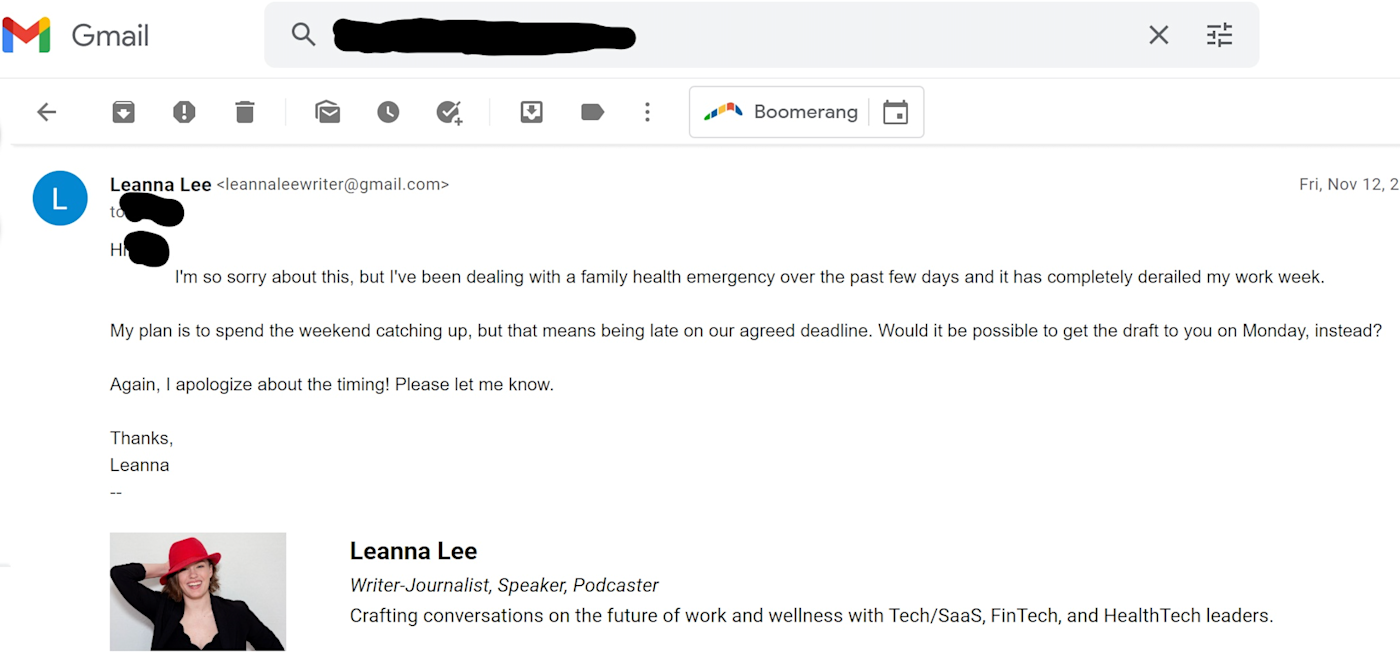Talking about mental health is never easy, especially when you’re self-employed. But it’s a conversation I have to have constantly because I live with two anxiety disorders (generalized anxiety and PTSD) and chronic depression. Whether you’re struggling with wellness and it’s affecting your work, or the work itself is causing stress, it’s important to know how to address it with clients.
Here are two different approaches that work for me.
Approach #1: Open and direct
I want to start by acknowledging that this is still the best-case scenario. We’ve come a long way in talking about mental health concerns at work, but it’s not an easy topic and can still come with professional consequences.
For this method to work, it’s extremely important to have a good rapport and healthy communication with a client you trust. Even more crucially, it requires a willingness and the ability for you to be open about your mental health. If those requirements don’t fit your current situation, feel free to focus on Approach #2 (though I still suggest reading through this one!).
When it comes to mental health-related interactions with my clients, I’m usually dealing with one of three scenarios:
-
Introducing myself and my mental health to a new client
-
Asking a client for more flexibility on a project when I’m having a bad day or am in crisis
-
Addressing issues or pushback with a current client that are affecting my wellbeing
Introducing yourself
The few times I’ve been open and direct about my mental health to new clients, I’ve already established enough of a rapport for them to know my story of chronic, ongoing anxiety and depression. Many of those clients have their own mental health stories, which makes the conversation much easier.
If you don’t have a personal connection in place yet, one way to gauge if you can be open with a potential client is to ask how they approach mental health at their company. It’ll also give you a sense of whether they’ll be a good fit and provide you an opening to say “the reason I ask is that I sometimes deal with X…”
Tip: Share how you prefer to work, and leave clients an open invitation to have a more personal discussion about wellness at work later.
When you’re struggling
If you’re struggling with a project or having a bad day, letting a good client know should be as simple as sending a quick email or text.
Example: “Hi X, I’m dealing with some mental health stuff today and need a bit more time on our project. Do you mind if I submit it tomorrow/X date instead?”
Here’s an actual text I sent last year to a long-standing client during a project.

On bad days, having a standard or canned answer ready to go can really alleviate stress and allow you to focus on recovery. You could even use a text expander to make things easier on yourself.
Tip: Tell your client about your situation as early as possible and either suggest an alternative day for submitting your work, or let them know when you’ll check in with a new due date.
Dealing with stressful clients or projects
A few years ago, I chose to take on a project I knew I’d hate because I adored my client (a boutique marketing agency). It got so bad that I’d panic every time I opened my computer. Eventually, I confessed to my contact in tears. And while she was sweet and understanding, it was a messy transition that damaged the client relationship, all because I ignored my own boundaries.
Point is, even if you have a good client and work well together, stressful situations can crop up.
First, try to identify the source of your stress: is it the project, your contact, or the client? Could it be you, your mental health, the timing, or other external factors? Think carefully about all the circumstances, and be honest with yourself about your own involvement.
No one wants to hear “we need to talk,” but an “I’m having a hard time with this project. Can we hop on a call to discuss?” will help you get past that initial awkwardness. Remind them of the positive aspects of your relationship, lay out the problems as simply as you can, and offer potential solutions.
Tip: Look at every stressful situation as a learning experience. If the problem was the project or the client, that’s a good sign that you may need to set some new work boundaries. If you were even partially responsible, it’s probably time for a self-assessment.
Approach #2: Direct, but not open
There is zero need to be upfront if you don’t want to or are concerned that it will affect your livelihood. Talking about your mental health upfront can and has led to discrimination, false assumptions, and soured professional relationships. I’m a mental health advocate who writes about mental health, and I still choose not to disclose my private life to everyone all the time.
This method can be used with any client, and you don’t necessarily need to build up a rapport beforehand.
Introducing yourself
For this approach, I tend to lean into the professional rather than the personal. Instead of sharing my mental health story, I lay out my approach to work and how we can work best together.
Focus on how you’re a business that supports worker mental health and what that looks like in terms of communication, work hours, mental health days, and project deadlines. When I talk to potential new clients about scope, I mention my minimum turnaround times, when I’m available for communication and calls based on timezone, and any upcoming time off.
You don’t even have to mention mental health at all if you don’t want to—just lay out the boundaries that allow you to work well.
Tip: A great resource for sharing mental health details professionally is Manual of Me, a tool created by freelance mental health community, Leapers. My Manual of Me lays out my ideal clients, work style, and most important boundaries.
When you’re struggling
As a birthparent, talking about my daughter (who I placed for adoption at birth) can be a sensitive subject. So when people ask if I’m a parent or have kids, my answer varies. And that’s ok. Same thing with mental health: if you don’t feel like going into details, you don’t have to.
In an emergency, you still want to reach out to your client as soon as you can. But this time, choose more neutral wording, like:

Tip: If you need more time to “dig in” to a project and mental health is getting in the way, let the client know that giving you a few extra days will achieve better results. I learned this from my wonderful business friend, Chrissy Kozol, who was our guest on a recent Bettermental episode.
Dealing with stressful clients or projects
Similar to the first approach, it’s important to assess the situation objectively (or as objectively as possible, anyway) before talking to your client. The message is the same; it just comes from a different angle.
Rather than leading with how the project is affecting you, summarize your concerns along with the terms of your agreement, so they can see the difference. Make sure the original scope you’ve agreed on is spelled out explicitly in your contract, statement of work (SOW), or at the very least, emails, so there’s a record you can refer back to.
Tip: Consider adding your work approach (boundaries, limitations, personal work terms) to your standard contract or SOW. You can even share a Manual of Me-type document at the beginning of your relationship to establish your expectations upfront.
But what if they push back?
At some point or another, you’re going to deal with unhappy clients; it’s just the cost of doing business.
The first thing I do before even talking to a pushy client is to write them out of my income for the month. A bit drastic, right? But stress like this can easily lead to a mental health crisis if I’m not careful. And there’s a lot of comfort in knowing that I’ll be covered financially if I have to choose my mental health over working with them. If I’m short on savings, I’ll reduce my monthly expenses temporarily and start reaching out to other clients about extra work.
Then, the best way to respond to client pushback will depend on the exact circumstances. But your response will come a lot easier once you decide how much energy you want to put into the relationship. Here are a few factors to consider:
-
How long the issue has been going on. Is it a one-time thing or an ongoing problem? If this is a new client, I’d probably just let them know we aren’t a good fit.
-
How good your relationship is. Setting aside the issue, are they a good client?
-
Whether you should or can negotiate/compromise. Remember, this is your mental health we’re talking about.
-
How valuable the client is to you. Do you really need or want them, or are they replaceable? Another great reason to deal with finances first: the value of the client relationship becomes a lot clearer once money is off the table.
Now comes the hard part: finding the right words. I can’t tell you exactly what to say, but here are a few potential options based on how you want to move forward.
Scenario #1: Keeping the client
“Hi CLIENT, I’m sorry this [boundary, time off, solution to an issue] isn’t going to work for you.
I really want to make sure we keep this project on track, so how would you feel about this instead: [share the compromise you’ve decided on, such as a shortened deadline, discount, or adjusted boundary].”
Scenario #2: Letting go of the client
“Hi CLIENT, I’m sorry this [boundary, time off, solution to an issue] isn’t going to work for you.
Unfortunately, I don’t have a better solution to offer and think it would be best if we end our work together here. Therefore, I would like to [give X notice according to our contract / send a partial or discounted invoice / other project wrap-up scenario]. “
There’s no easy way to handle this, but being prepared financially and emotionally can help you face any potential lashback and act promptly and effectively on your decision.
Finally, some mental health disclaimers
I’m not (and never will be) a mental health professional. But as someone who has lived with chronic mental health issues my entire professional life, I’ve learned that there’s no separating the two. I live and work a lot better when my health is the priority.
But every mental health experience is unique, and there’s no one right way to make your needs known, especially when disclosing them is difficult. I can only share what I’ve done and what’s worked for me.
The most important thing you can do is learn what your own mental health needs are and find a professional approach that works best for you.
[adsanity_group align=’alignnone’ num_ads=1 num_columns=1 group_ids=’15192′]
Need Any Technology Assistance? Call Pursho @ 0731-6725516




